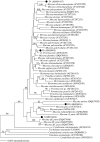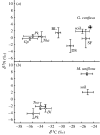Evidence for novel and specialized mycorrhizal parasitism: the orchid Gastrodia confusa gains carbon from saprotrophic Mycena
- PMID: 19004757
- PMCID: PMC2660934
- DOI: 10.1098/rspb.2008.1225
Evidence for novel and specialized mycorrhizal parasitism: the orchid Gastrodia confusa gains carbon from saprotrophic Mycena
Abstract
We investigated the physiological ecology of the Asian non-photosynthetic orchid Gastrodia confusa. We revealed its mycorrhizal partners by using molecular identification and identified its ultimate nutritional source by analysing carbon and nitrogen natural stable isotope abundances. Molecular identification using internal transcribed spacer and large subunit nrDNA sequences showed that G. confusa associates with several species of litter- and wood-decomposer Mycena fungi. The carbon and nitrogen isotope signatures of G. confusa were analysed together with photosynthetic plant reference samples and samples of the ectomycorrhizal epiparasite Monotropa uniflora. We found that G. confusa was highly enriched in (13)C but not greatly in (15)N, while M. uniflora was highly enriched in both (13)C and (15)N. The (13)C and (15)N signatures of G. confusa were the closest to those of the fruit bodies of saprotrophic fungi. Our results demonstrate for the first time using molecular and mass-spectrometric approaches that myco-heterotrophic plants gain carbon through parasitism of wood or litter decaying fungi. Furthermore, we demonstrate that, several otherwise free-living non-mycorrhizal, Mycena can be mycorrhizal partners of orchids.
Figures


Similar articles
-
The importance of associations with saprotrophic non-Rhizoctonia fungi among fully mycoheterotrophic orchids is currently under-estimated: novel evidence from sub-tropical Asia.Ann Bot. 2015 Sep;116(3):423-35. doi: 10.1093/aob/mcv085. Epub 2015 Jun 25. Ann Bot. 2015. PMID: 26113634 Free PMC article.
-
Independent recruitment of saprotrophic fungi as mycorrhizal partners by tropical achlorophyllous orchids.New Phytol. 2009 Nov;184(3):668-681. doi: 10.1111/j.1469-8137.2009.02987.x. Epub 2009 Aug 19. New Phytol. 2009. PMID: 19694964
-
Diverse mycorrhizal associations and nutrition in Didymoplexis orchids.Mycorrhiza. 2025 Apr 26;35(3):34. doi: 10.1007/s00572-025-01208-5. Mycorrhiza. 2025. PMID: 40285927
-
Myco-heterotroph/epiparasitic plant interactions with ectomycorrhizal and arbuscular mycorrhizal fungi.Curr Opin Plant Biol. 2004 Aug;7(4):422-8. doi: 10.1016/j.pbi.2004.04.004. Curr Opin Plant Biol. 2004. PMID: 15231265 Review.
-
Myco-heterotrophy: when fungi host plants.Ann Bot. 2009 Dec;104(7):1255-61. doi: 10.1093/aob/mcp235. Epub 2009 Sep 18. Ann Bot. 2009. PMID: 19767309 Free PMC article. Review.
Cited by
-
Root Endophytic Fungal Community and Carbon and Nitrogen Stable Isotope Patterns Differ among Bletilla Species (Orchidaceae).J Fungi (Basel). 2021 Jan 20;7(2):69. doi: 10.3390/jof7020069. J Fungi (Basel). 2021. PMID: 33498277 Free PMC article.
-
The importance of associations with saprotrophic non-Rhizoctonia fungi among fully mycoheterotrophic orchids is currently under-estimated: novel evidence from sub-tropical Asia.Ann Bot. 2015 Sep;116(3):423-35. doi: 10.1093/aob/mcv085. Epub 2015 Jun 25. Ann Bot. 2015. PMID: 26113634 Free PMC article.
-
A plant growth-promoting symbiosis between Mycena galopus and Vaccinium corymbosum seedlings.Mycorrhiza. 2017 Nov;27(8):831-839. doi: 10.1007/s00572-017-0797-5. Epub 2017 Aug 25. Mycorrhiza. 2017. PMID: 28842791
-
Extreme overall mushroom genome expansion in Mycena s.s. irrespective of plant hosts or substrate specializations.Cell Genom. 2024 Jul 10;4(7):100586. doi: 10.1016/j.xgen.2024.100586. Epub 2024 Jun 27. Cell Genom. 2024. PMID: 38942024 Free PMC article.
-
Subterranean morphology underpins the degree of mycoheterotrophy, mycorrhizal associations, and plant vigor in a green orchid Oreorchis patens.Plant J. 2025 Feb;121(4):e70045. doi: 10.1111/tpj.70045. Plant J. 2025. PMID: 39969432 Free PMC article.
References
-
- Altschul S.F., Madden T.L., Schaffer A.A., Zhang J., Zhang Z., Miller W., Lipman D.J. Gapped BLAST and PSI-BLAST: a new generation of protein database search programs. Nucleic Acids Res. 1997;25:3389–3402. doi:10.1093/nar/25.17.3389 - DOI - PMC - PubMed
-
- Bidartondo M.I. The evolutionary ecology of myco-heterotrophy. New Phytol. 2005;167:335–352. doi:10.1111/j.1469-8137.2005.01429.x - DOI - PubMed
-
- Bidartondo M.I., Bruns T.D. Extreme specificity in epiparasitic Monotropoideae (Ericaceae): widespread phylogenetic and geographical structure. Mol. Ecol. 2001;10:2285–2295. doi:10.1046/j.1365-294X.2001.01358.x - DOI - PubMed
-
- Bidartondo M.I., Redecker D., Hijri I., Wiemken A., Bruns T.D., Dominguez L., Sersic A., Leake J.R., Read D.J. Epiparasitic plants specialized on arbuscular mycorrhizal fungi. Nature. 2002;419:389–392. doi:10.1038/nature01054 - DOI - PubMed
-
- Bidartondo M.I., Bruns T.D., Weiss M., Sergio C., Read D.J. Specialized cheating of the ectomycorrhizal symbiosis by an epiparasitic liverwort. Proc. R. Soc. B. 2003;270:835–842. doi:10.1098/rspb.2002.2299 - DOI - PMC - PubMed
Publication types
MeSH terms
Substances
LinkOut - more resources
Full Text Sources

